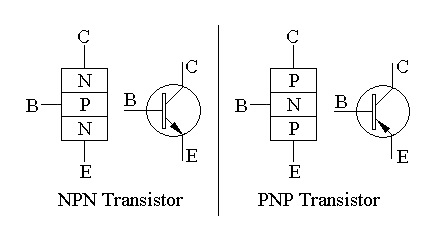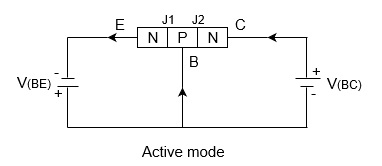
 Data Structure
Data Structure Networking
Networking RDBMS
RDBMS Operating System
Operating System Java
Java MS Excel
MS Excel iOS
iOS HTML
HTML CSS
CSS Android
Android Python
Python C Programming
C Programming C++
C++ C#
C# MongoDB
MongoDB MySQL
MySQL Javascript
Javascript PHP
PHP
- Selected Reading
- UPSC IAS Exams Notes
- Developer's Best Practices
- Questions and Answers
- Effective Resume Writing
- HR Interview Questions
- Computer Glossary
- Who is Who
Bipolar Junction Transistor
A Bipolar Junction Transistor (BJT) is a three terminal circuit or device that amplifies flow of current. It is solid state device that flows current in two terminals, i.e., collector and emitter and controlled by third device known as terminal or base terminal. Unlike a normal p-n junction diode, this transistor has two p-n junctions. The basic symbols of BJT are n-type and p-type. Electronic current is conducted by both free electrons and holes in bipolar junction transistor.
Terminals of Bipolar Junction Transistors
There are three terminals in bipolar junction transistors are explained below.
Emitter − It supplies charge carriers. It is highly doped so that it can inject a large number of charge carriers into the base. Emitter is always greater than base.
Base − Base is middle layer in BJT which is thin compared to emitter and collector. Base is very lighted doped.
Collector − It collects charge carriers. Its doped between emitter and base means moderately doped, but it is always greater than emitter and base in size.
Types of Bipolar Junction Transistors
Since a semiconductor has less resistance to flow current in one direction and high resistance in another direction. The device mode of a semiconductor is transistor. There are two types of transistors, i.e., point contact and junction transistor in bipolar junction transistors. Junction transistor are used more than point type transistor. Junction transistor are also types based on their construction. These are:
NPN Junction Transistors
In this transistor, a single p-type semiconductor layer is sandwiched between two n-type semiconductor layers.
PNP Junction Transistors
In this transistor, a single n-type semiconductor layer is sandwiched between two p-type semiconductor layers.

Bipolar junction transistors are formed by sandwiching either n-type or p-type. The electrodes for each junction transistor are: emitter, base, and collector.
BJT operation modes
There are three modes: Cut-off mode, saturated mode, and active mode in bipolar transistor junction. We need supply dc voltage to npn or pnp transistors in order to operate transistor in one of these regions. Transistor operates in any of these regions based on polarity of dc voltage. Applying dc voltage means biasing of transistor.
Cutoff mode
In this mode, both junctions are reversed biased so no current flows through the device. Hence, transistor is in off mode and acts like open switch. This mode is used for switch OFF application.

Saturated mode
In this mode, both junctions are forward biased so current flows through the device. Hence, transistor is in on mode and acts like closed switch. This mode is used for switch ON application.

Active mode
In this mode, one junction (emitter to base) is forward biased and another junction (collector to base) is reverse biased. This mode is used for amplification of current.

Advantages of BJT
These are advantages of bipolar junction transistors:
- It has high frequency operation,
- It has high driving capability,
- It can be used as digital switch.
Applications of BJT
Bipolar junction transistors are mainly used in switching and amplification. Applications of BJT include:
- Radio transmitters
- Audio amplifiers
- Televisions
- Computers
- Mobile phones

